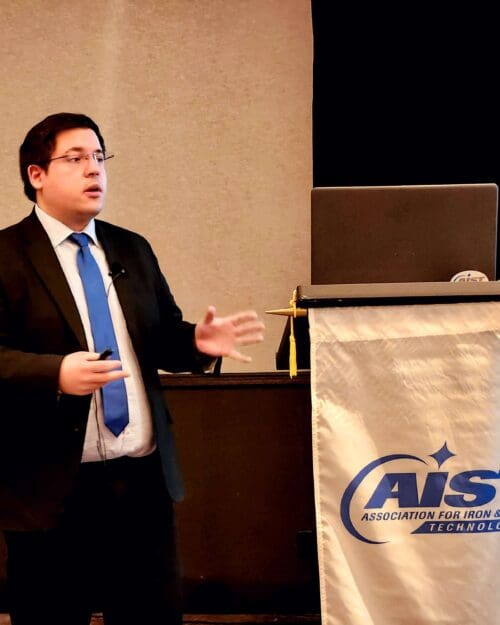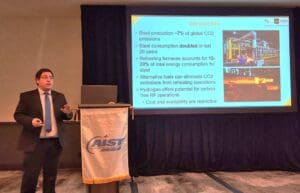CIVS Hydrogen Research in a Reheating Furnace Highlighted at an International Symposium

 On June 3, CIVS Senior Research Engineer, Nicholas Walla, as a Keynote Speaker, presented “Computation Modeling of H2/CH4 Combustion in a Slab Reheating Furnace” at the 3rd International Symposium on the Recent Developments in Plate Steels in Vail, CO. The co-authors of the paper include CIVS Associate Director for Operations Armin Silaen, CIVS Director Chenn Zhou, PNW graduate student Abhishek Kolakotla, Cleveland Cliffs Research Engineer Kurt Johnson, and Cleveland Cliffs Manager Lawrence (Larry) Fabina. Over 150 attendees from 19 countries were present at the symposium.
On June 3, CIVS Senior Research Engineer, Nicholas Walla, as a Keynote Speaker, presented “Computation Modeling of H2/CH4 Combustion in a Slab Reheating Furnace” at the 3rd International Symposium on the Recent Developments in Plate Steels in Vail, CO. The co-authors of the paper include CIVS Associate Director for Operations Armin Silaen, CIVS Director Chenn Zhou, PNW graduate student Abhishek Kolakotla, Cleveland Cliffs Research Engineer Kurt Johnson, and Cleveland Cliffs Manager Lawrence (Larry) Fabina. Over 150 attendees from 19 countries were present at the symposium.
The steel industry supplies one of the most critical materials for U.S. manufacturing, infrastructure and defense. The slab reheating furnace, an essential steelmaking process, is energy-intensive and generates significant CO2 emissions from natural gas combustion. Computational fluid dynamics (CFD) simulation has become a powerful tool for research and development to optimize furnace performance and to increase energy efficiency and productivity, as well to explore alternative fuels such as hydrogen to reduce CO2 emissions. This paper presents an overview of state-of-the-art CFD simulations of industry-scale reheating furnaces. Examples from Purdue University Northwest’s Center for Innovation Through Visualization and Simulation (CIVS) and Steel Manufacturing Simulation and Visualization Consortium (SMSVC) are included.
This symposium highlighted steelmaking and casting, hot rolling, accelerated cooling and direct quenching, flatness control, line pipe, hydrogen-induced-cracking (HIC)-resistant steels, microstructure characterization, product strategies, as-rolled steels, heat-treated steels, welding, and hardfacing. As-rolled steel applications include wind tower, offshore structures, shipbuilding and abrasion-resistant steels used in construction and machinery. Heat-treated steel applications include tank cars, pressure vessels, and quenching and partitioning to enhance steel product toughness and wear resistance.
The Association for Iron & Steel Technology (AIST) is a non-profit organization with 15,500 members from over 70 countries. With 30 Technology Committees and 22 Local Members Chapters, AIST represents an incomparable steel industry knowledge and expertise network. Their mission is to advance the technical development, production, processing, and application of iron and steel.


